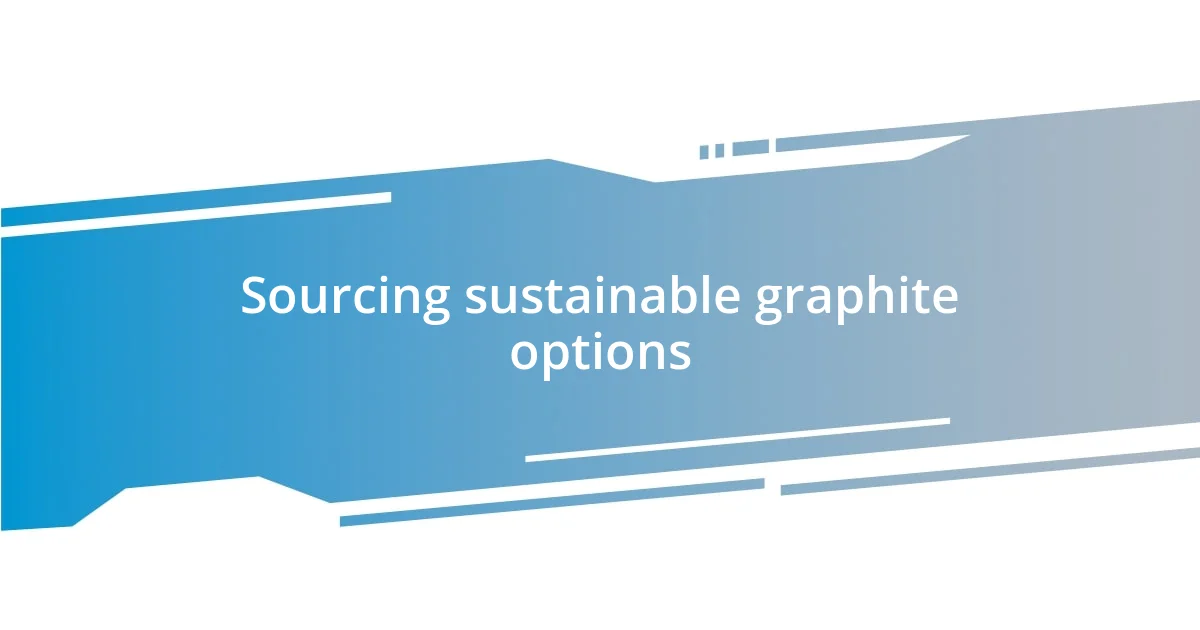Key takeaways:
- Understanding different types of graphite (crystalline, amorphous, and synthetic) is crucial for selecting materials that meet specific application needs.
- Establishing long-term relationships with reliable suppliers, focusing on their reputation, certifications, and quality assurance practices, is key to securing high-quality graphite.
- Sourcing sustainable graphite has gained importance, emphasizing the need for ethical practices and transparency in supply chains while adapting to market trends like the rise of synthetic graphite.

Understanding graphite material types
When diving into graphite material types, it’s fascinating how the variations can influence their applications. For instance, I remember the first time I worked with crystalline graphite. Its unique layered structure caught my attention, allowing for exceptional conductivity and lubricant qualities. Have you ever considered how such properties could impact your projects?
Then there’s the amorphous graphite, which I often refer to as the hidden gem of the graphite family. It doesn’t have the same structural arrangement as its crystalline counterpart, yet it’s surprisingly versatile. In my experience, working with amorphous graphite has opened up opportunities in production processes that require higher thermal stability—something that surprised me at first but soon became indispensable in my applications.
Lastly, synthetic graphite deserves a mention as it showcases human ingenuity in material science. I once attended a workshop on its production, and witnessing how precisely controlled processes could yield uniform properties was eye-opening. Isn’t it interesting how these engineered materials can push the boundaries of what’s possible in technology?

Identifying reliable suppliers
Identifying reliable suppliers is crucial in my sourcing journey for high-quality graphite materials. I’ve learned that not all suppliers are created equal, so checking their background is essential. For instance, I once partnered with a supplier whose quality assurance practices turned out to be more talk than action, leading to frustrating delays.
When assessing suppliers, it’s wise to explore their industry reputation. I remember reaching out to various manufacturers and asking for references. The feedback I got helped me distinguish between suppliers who consistently delivered on quality versus those who didn’t. Have you ever relied on word of mouth to gauge a supplier’s trustworthiness? I’d say that personal connections can be vital in making that leap of faith.
Don’t overlook certifications and compliance. I once discovered a potential supplier had major quality certifications that reassured me about their products. It’s fascinating how these credentials can serve as a safety net, ensuring that the materials meet specified industry standards. Ultimately, investing time in identifying the right suppliers can yield fruitful partnerships in the long run.
| Supplier Criteria | Considerations |
|---|---|
| Reputation | Reviews and references from previous clients |
| Certifications | Industry-specific certifications and compliance |
| Quality Assurance | Processes in place to manage and ensure quality |

Evaluating quality and standards
When I assess the quality of graphite materials, I focus on several critical factors. I usually start with purity, as impurities can significantly affect performance. I remember a batch I received once, and it was heart-wrenching to see how a few contaminants in the graphite completely altered its conductivity. Quality measurements can provide insight into how well the material meets industry standards.
To gauge quality effectively, here’s what I recommend considering:
- Purity Levels: Look for low impurity contents; ideally, >99% purity is what I aim for.
- Particular Size Distribution: This can impact performance, particularly in applications requiring thermal conductivity.
- Mechanical Properties: Strength and flexibility can make or break a project, so these specs are essential.
- Testing Reports: Always ask for third-party testing results to get an unbiased view of what you’re purchasing.
I’ve found that a thorough assessment checklist makes the process less daunting and more systematic. It’s a focal point that keeps my quality assurance efforts on track.

Testing for purity and performance
When it comes to testing for purity and performance, I’ve learned that nothing beats hands-on testing. I remember receiving a shipment that looked pristine, but samples quickly revealed unexpected impurities. That moment highlighted for me how important it is to not just trust appearances. I always advocate for rigorous lab tests that break down purity levels—aiming for that >99% mark can genuinely elevate your material’s reliability.
It’s also vital to evaluate performance under actual working conditions. I often wonder how many people overlook this aspect. For instance, I once used a specific graphite type in an application that required high thermal conductivity. After thorough testing, the results were surprising; rather than enhancing performance, it actually underperformed due to certain impurities that weren’t visible to the naked eye. The lesson? Performance testing should match the intended application; don’t just test the material in a vacuum.
Finally, maintaining open communication with suppliers about testing results is key. I’ve had discussions that turned revealing; suppliers often share insights that explain results or trends in their materials. This exchange builds not just trust, but also an invaluable partnership. Trust me, tapping into these conversations can lead to better material choices, and in turn, more successful projects.

Sourcing sustainable graphite options
Sourcing sustainable graphite materials has become a vital focus for me in recent years. I can’t help but think about the environmental impact of every decision I make. The thrill of discovering suppliers who are committed to ethical sourcing practices gives me hope. For example, I once partnered with a company that sources graphite from mines committed to reforestation efforts. Not only did I secure high-quality material, but I felt like I was contributing to a positive change.
I also pay close attention to suppliers that have transparent supply chains. Have you ever stopped to consider how much of an impact this transparency can have? I had a conversation with a supplier who openly shared their environmental certifications. This openness built my trust, and ultimately, my peace of mind when placing orders. It’s fascinating to see how suppliers ready to share their commitment to sustainable practices not only attract conscientious buyers but also foster a community focused on responsible material procurement.
Moreover, I often explore alternatives to traditional graphite sources. Lately, I’ve been experimenting with synthetic graphite that boasts lower environmental impacts. It’s like a little light bulb went off when I discovered that this material doesn’t just meet performance standards but also addresses sustainability concerns. I recall the excitement of testing synthetic options, realizing I could achieve performance without compromising environmental ideals. That feeling of merging ethics with efficacy is something I cherish.

Establishing long-term supplier relationships
Establishing long-term relationships with suppliers has become one of my core strategies in sourcing high-quality graphite materials. I remember my first experience with a supplier—it was a rocky start, filled with miscommunication and missed deadlines. But over time, I made it a point to engage regularly. By setting up quarterly meetings, I fostered a rapport that transformed our business dynamics. Have you ever tried investing time in a relationship only to see it bloom? It’s incredibly rewarding.
A key aspect I’ve found essential is reliability. When I rely on a supplier for critical deliveries, I want to know they can deliver consistently. There’s this one supplier I’ve worked with who, despite a few hiccups, always made an effort to communicate any delays and offer solutions. Their dedication reminded me that a transparent relationship can weather the storms together. It’s about creating a partnership that thrives on mutual support.
Trust is also hugely significant. I frequently revisit my suppliers to discuss future trends and upcoming challenges. I often pose questions like, “What innovations are you exploring?” It’s fascinating how often this has opened doors for collaborative projects that benefit both sides. Establishing trust isn’t just a course of action; it’s a long-term investment that can lead to unique opportunities and shared success down the road.

Analyzing market trends in graphite
Analyzing market trends in graphite has become a fascinating journey for me. One particular trend that stands out is the increasing demand for high-quality, sustainable graphite, driven by industries focusing on eco-friendly solutions. I remember attending a recent trade show where many suppliers showcased their advancements in sustainable practices. It struck me how this shift not only enhances product quality but also aligns with consumer values—something that’s increasingly important in today’s market.
Another noteworthy trend is the rise of synthetic graphite. I’ve had my doubts about its performance compared to natural forms, but my perspective changed when I tested several synthetic options for a project. The results were impressive, revealing that this material could offer similar or even superior qualities while addressing environmental concerns. Does anyone else find it exciting how technology can reshape traditional materials? It’s like watching an artist discover new mediums; the possibilities are endless.
Lastly, I can’t help but notice how digital tools are reshaping supply chain dynamics. I recently started using a market analysis platform that provides real-time insights on pricing and demand fluctuations—something I didn’t realize could streamline my sourcing process so much. Have you considered how embracing technology might enhance your strategies? The ability to access timely data transforms not just how I source materials, but also how I anticipate market shifts. It’s an exhilarating time to be involved in the graphite industry!














